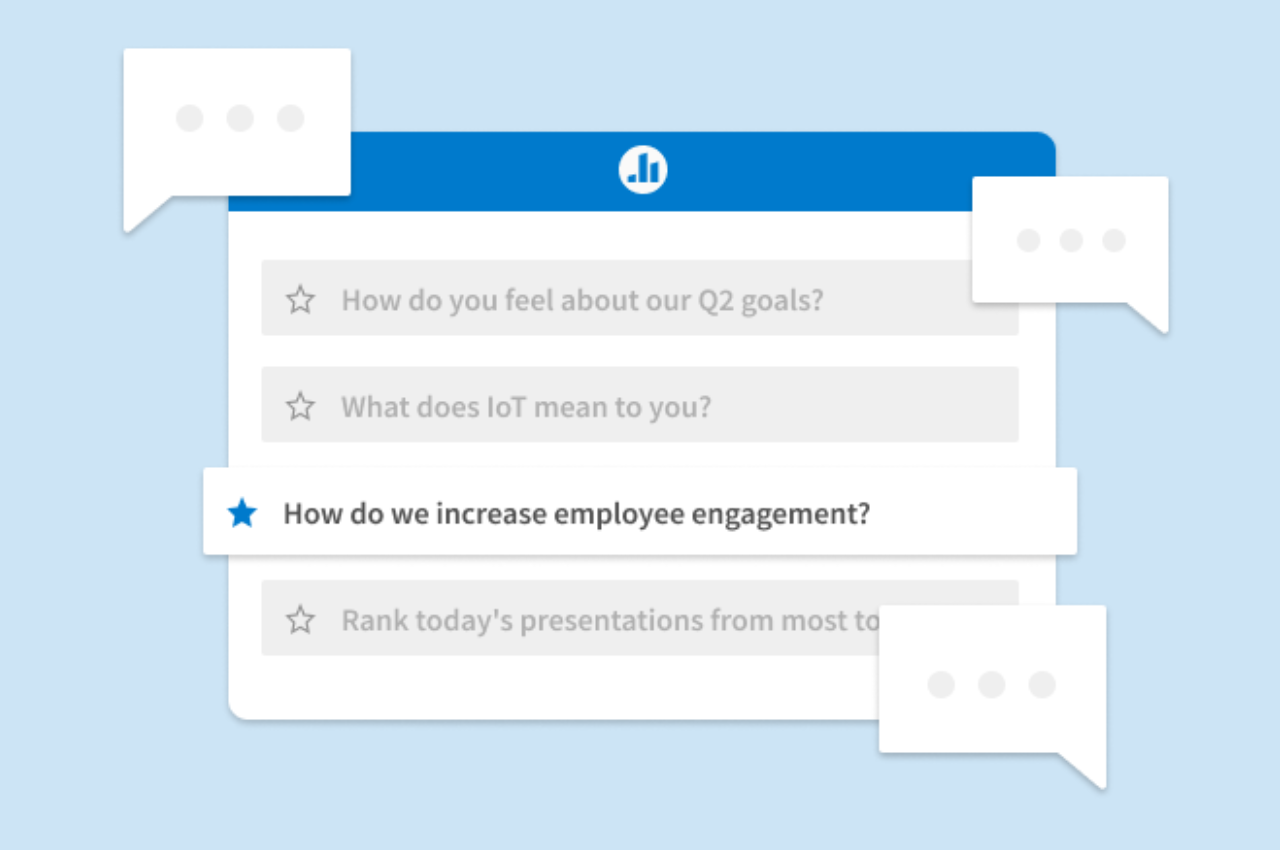Employee feedback: Why it’s important and 10 great examples

There are four words that are all but guaranteed to strike fear into the heart of any employee when uttered by their manager: “We need to talk.”
Even for the most dedicated and highest-performing employees, the thought of being pulled aside by a supervisor can cause a spike in stress and send one’s imagination running wild. But it doesn’t have to be this way! At workplaces with great company cultures, feedback isn’t an occasional source of dread but a regular occurrence that’s seen as a genuine growth opportunity.
When implemented properly, employee feedback is a valuable asset. It can improve communication between coworkers, align expectations throughout your organization, and give individuals the chance to develop both personally and professionally.
What is employee feedback?
Employee feedback is an exchange of information related to workplace performance, skills, and priorities or employees’ ability to work well with others. Feedback can and should happen between peers, managers and their team members, and executives and their workforce.
Feedback can be delivered formally or informally, but it shouldn’t be something that only happens during an annual performance review. And while most people don’t like to be micromanaged, a majority of workers feel like they’re not getting enough coaching from managers or peers. Research from Zippia shows 65% of employees say they’d like to receive more feedback at work.
Why is employee feedback so important?
While effective employee feedback can certainly impact job performance by reinforcing good habits and breaking bad ones, its benefits go beyond improving skill sets.
The quality and regularity of employee evaluations are also major factors in employee engagement. Data from Gallup shows 84% of employees who received meaningful feedback in the past week described themselves as actively engaged at work, compared to just 22% of workers who didn’t receive regular direction.
Everybody likes to hear they’re doing a great job, but when it comes to letting employees know where they stand, even bad news is better than no news. According to research from Zippia, employees who received no feedback at all were nearly twice as likely to be actively disengaged compared to those who received negative comments. That suggests the majority of people truly want to get better at their jobs, even if it requires some hard conversations along the way.

How to give useful employee feedback
Ideally, workplace feedback should strike a balance between positive reinforcement and constructive criticism. Nobody wants to feel like they’re on the receiving end of a compliment quota—or like they’re constantly having to defend themselves and their decision-making.
When delivered tactfully and thoughtfully, feedback from managers or peers can strengthen workplace relationships and help colleagues better understand one another. Keep these tips in mind next time you’re coaching a direct report or sharing your perspective with a colleague.
Know the time and place.
Everyone loves receiving positive feedback, especially if it’s genuine. However, when it comes to offering constructive criticism, save it for things that make a significant impact on productivity, business relationships, or other team members. Make sure you’re feeling calm and invested in solutions rather than stressed or confrontational. Unless you’re dealing with unsafe or offensive behavior that affects everyone, one-on-one conversations are usually preferable to calling somebody out in a group setting.
When possible, speak instead of type.
Words on a screen are frequently misinterpreted, causing confusion and anxiety for senders and recipients alike. Up to 50% of emails may be perceived differently than the sender intended, leading to the recipient feeling defensive or misunderstanding the sender’s intent. Whether it’s an in-person meeting or a video call, the personal connection that comes from hearing voices and seeing body language often soothes tensions that can arise in text, email, or chat conversations.
Be specific and offer context.
Whether you’re delivering a compliment or a well-meaning critique, it’s best to be specific about why someone’s actions were exemplary, or why they may justify some self-reflection. When conveying your message, avoid generalizations or character judgments. Instead, focus on actions and outcomes and how they affected you or any other parties involved.
Make room to listen.
In the modern workplace, employee feedback should feel like a two-way conversation where both parties have each other’s best interests in mind. To better understand where employees are coming from and the issues they may be facing at work or personally, managers should focus on active listening for a significant portion of any job-performance conversation.
Encourage candor with anonymous feedback.
Ideally, relationships between managers and their employees should facilitate open conversation. However, there are times when anonymous feedback can be useful to cancel out power imbalances and encourage employees to speak their minds. Consider utilizing regular anonymous surveys to check in with your workforce about what’s working well and what could be improved.
Look forward, not backward.
While it’s important for people to understand why you’re asking them to do something differently, harping on previous mistakes isn’t particularly productive. Instead, focus on identifying a path forward, and learning how you can support this person in their efforts to make a change. Be willing to validate their perspective and listen to their concerns, and work to arrive at a collaborative solution with clear expectations for both parties.
10 examples of great employee feedback
From positive reinforcement to constructive criticism, we’ve pulled together several examples of impactful employee feedback and a brief explanation of why they’re effective. While it’s impossible to cover every workplace scenario, these examples should serve as a good starting point for how to deliver feedback from a place of empathetic leadership.
1. Recognizing an individual contribution
“You were amazing in that presentation this afternoon! I know you put a ton of time into those competitive research slides, and they looked really impressive. Great job answering the client’s questions as well.”
Why it’s effective:
It acknowledges the individual’s efforts with specific mentions of what stood out rather than generic or impersonal feedback.
2. Acknowledging an accomplishment
“We had some really aggressive sales targets this quarter, and we couldn’t have beat them without the new accounts you brought on. I really appreciate you taking the initiative to grow the business while still servicing your current customers.”
Why it’s effective:
It establishes common ground around a shared goal and recognizes the traits that will help the employee continue to be successful.
3. Calling out great teamwork
“I just wanted to let you know I’ve noticed how well you’re collaborating with the design team on this project. Getting your requests in earlier has really made it easier for us to plan out workloads and timelines.”
Why it’s effective:
It recognizes an employee’s improvement and offers specific context around how their efforts benefit the rest of the team.
4. Offering guidance on priorities
“I can tell you’re passionate about [lower-priority task], which is fantastic. Though for us to stay on schedule, we really need to focus on [higher-priority task] this month. Do you have everything you need to keep moving forward?”
Why it’s effective:
It refocuses the employee’s efforts without invalidating the work they’ve been doing, gives them context around why you’re making the request, and offers an opportunity to discuss any roadblocks.
5. Addressing late projects or missed deadlines
“While I appreciate you wanted to take your time to get everything right on this project, delivering your portion late impacted the rest of the team, and [coworker] had to work several late nights in a row to catch up. How can we make it easier to sound the alarm if you’re falling behind on a project and need some support?”
Why it’s effective:
It helps the employee understand how their actions affect others and invites them to participate in finding solutions moving forward.
6. Managing tension between coworkers
“Things got a little heated in that strategy meeting yesterday afternoon. While I know we’re going to have different perspectives on which approach makes the most sense, we’re all on the same team here. Can you tell me more about your concerns? What do you think about scheduling a quick chat with [coworker] so we can find a solution that makes sense for everyone?
Why it’s effective:
It gives everyone a chance to process their emotions after a stressful situation, shows the employee you value their input, and offers a productive path toward a resolution.
7. Addressing low morale
“You’ve been really quiet in our update meetings lately when you’re usually bubbling with ideas. The rest of the team really feeds off of your enthusiasm, so I just wanted to check in on you and make sure you’re OK. Is there anything going on at work or in your home life? How can I help?”
Why it’s effective:
It shows the employee you care about them as a person, you recognize the value they bring to the company, and you’re giving them a chance to open up about whatever may be bothering them.
8. Improving team collaboration
“I love how excited you are about making this campaign as great as it can be. However, sometimes your enthusiasm makes it hard for other people to share their perspectives. You talked over [coworker] a number of times today and dismissed her idea before she had a chance to finish explaining it. Did you notice this happening during the meeting?”
Why it’s effective:
It recognizes the employee’s passion and gives them a chance to reflect on their behavior without feeling attacked.
9. Correcting unprofessional behavior
“I understand it can be frustrating when customers make unreasonable demands, but responding in anger hurts our business relationships. I know you want what’s best for this company, so let’s talk about some ideas for how to handle a similar situation next time.”
Why it’s effective:
It acknowledges the employees pain points, provides context on how their actions are negatively affecting the organization, and fosters a sense of shared purpose.
10. Feedback from outside the organization
“We got a call from a customer that they weren’t happy with the results of this most recent project. Can you tell us about what happened from your perspective so we can learn how to better manage their expectations going forward?”
Why it’s effective:
Asking the employee for their perspective in a non-accusatory tone prevents the employee from feeling blamed or singled out.
When organizations prioritize timely, thoughtful, and tactful feedback, they create stronger company cultures with highly engaged employees who are comfortable being coached. And when feedback becomes a two-way street from employees to management, open communication becomes a habit that helps good companies become great ones. Poll Everywhere makes it easy to gather anonymous employee feedback with open-ended Activities and Surveys so you can keep the feedback flowing in all directions and unlock new insights on your organization.
Looking for more ideas on how to create a more highly engaged workforce? Check out our employee engagement ebook and explore more ways to keep your employees connected to your company’s mission.